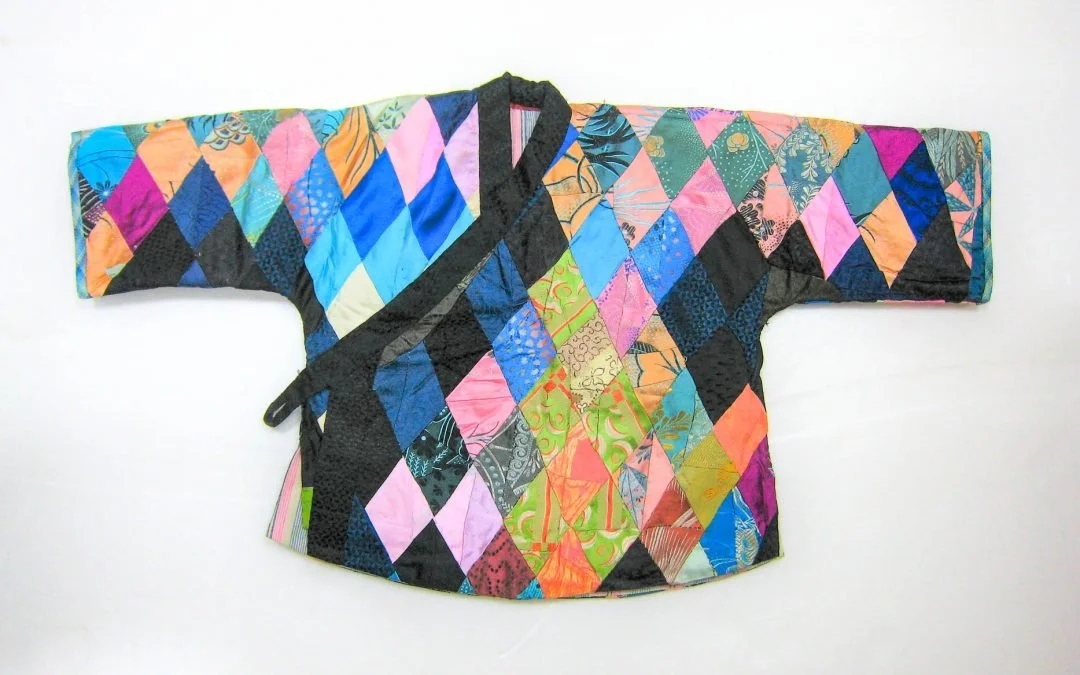The Magical Jacket
A few years ago, I read Grace Lin’s Where the Mountain Meets the Moon to my young children. It’s a story about a little girl who lives in the Valley of Fruitless Mountain. As its name suggests, the village is cursed with misfortune and barren soil, and its residents stricken with hunger and poverty. She subsists on the fantastical stories her father tells her and is especially taken by the character of the Old Man of the Moon, who her father claims can tell her how to bring vegetation and abundance back to Fruitless Mountain. Emboldened by her desire to bring happiness to her family, the little girl sets off on a journey to find the Old Man of the Moon. In the vein of the classic hero’s journey story, she meets friends and challenges along the way. In one village, she is given a multi-colored jacket to keep her warm before she ascends the mountain. Even though the jacket is made of mis-matched cotton scraps sewn together, the little girl immediately feels a deep sense of comfort and warmth when she puts it on. When she bids the villagers goodbye, the little girl is astounded when she notices that all the children’s jackets have a scrap missing from their sleeves.
At this point in the story, I stopped to ask my children why they thought there were missing pieces from the village children’s jacket sleeves. Without missing a beat, my eight-year-old son said, “Because they cut it out and put them together to make her jacket!” My daughter’s eyes lit up with realization and her nimble mind quickly added to her older brother’s explanation, “And! And! It’s like magic because all the little pieces became one very warm jacket!”
Children are such astute observers, and can so deftly make sense of the world through an understanding that extends beyond logic. I loved that my son immediately recognized the collective effort of the village children and that my daughter invoked magic to explain the jacket’s super warm qualities. They were able to extrapolate a reading of this detail in the story that was whole and poetic.
“What if I told you,” I offered the children, “that I could show you this magical jacket?” The children clamored into my lap and pleaded for me to show them. “Next time you come to Ama’s gallery,” I promised.
“Ama,” is what my children call their grandmother, my mother. And the “gallery” is a space in the offices of our family business – a children’s clothing brand and retailer in Taiwan – that houses my mother’s collection of handmade children’s clothing she has collected over the last thirty
years. The pieces in my mother’s collection – children’s hats, bibs, shoes, clothes, baby carriers – are from Taiwan, Southwestern China, and Southeast Asia; most are from the early to mid-20th century.
In my mother’s collection is a jacket that looks exactly like the warm coat described in Lin’s book. It is made of multi-colored diamonds of fabric, stitched together in a geometric pattern and lightly padded. This type of jacket is known as bai jia yi, a “hundred household garment.” Back when infant mortality rate was high in China, families welcoming a newborn baby would send someone to go out into the village to beg for scraps of fabric from as many households as possible. These scraps – each one imbued with the blessing of the family from where it came – would then be sewn together to form a jacket, shirt, or pants for the baby, forming a magical shield of protection for the baby. The garment was understood to be made from the blessings from one hundred households.
As promised, I brought my children to “Ama’s gallery” to show them the magical jacket. They were familiar with my mother’s collection of hand-embroidered or expertly wax-dyed objets d’art, but were never as impressed as the moment they laid eyes upon the bai jia yi. In terms of technique, quality of fabric, and composition, there are so many other items in my mother’s collection that inspire awe, but this jacket – one made from a mis-matched pastiche of leftover fabric scraps – was the one that elicited an audible wow from my children, because they understood the magic in creating something new out of something old. They could see the magic of having stories embedded within the fibers of the jacket, imbuing it with powers only its wearer could feel.
What a radical concept the bai jia yi embodies – not only does it illustrate the practicality of making something new out of old scraps, it proves how the value of something created through the intentional act of repurposing can be exponentially increased. The receiver of such a gift, like the little girl in Where the Mountain Meets the Moon, is protected by the physical reminder that she is a part of a larger community and her spirit is buoyed by the graces of many.
brenda Lin

